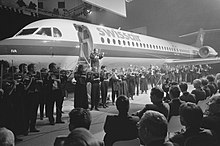Fokker 100
It is powered by two newer Rolls-Royce Tay turbofans, and it has an updated glass cockpit and a wider wing and tail for increased maximum weights.
Discussions regarding the potential for either portions or the entirety of Fokker being purchased by Bombardier Inc. are known to have taken place, but talks ultimately fell through without a deal being reached.
Dutch firm Stork B.V. has since acquired the maintenance business for the type and has since been providing services to existing operators, having adopted the name Fokker Aviation.
[13][14][12] In March 2010, NG Aircraft stated that it had securing funding from the Ministry of Economic Affairs to adapt an existing Fokker 100 to serve as a prototype for a planned improved new-build series;[15] that same month, the company announced its interest in converting existing aircraft to a proposed new-build equivalent standard, in addition to its primary focus of constructing wholly new Fokker 100s.
[13] Dubbed the F120NG, it would be a new-build aircraft, seating a maximum of 125 to 130 passengers, that would be essentially a stretched model of the base Fokker 100.
It would adopt a new powerplant, the Pratt & Whitney PurePower PW1X17G turbofan engine rated at 17,600 lb thrust, which is claimed to result in the new-generation airliner burning 50% less fuel per seat than the original Fokker 100.
[13] It was claimed in 2014 that the earliest entry-to-service date for the F120NG would have been 2019, based on a five-year development and testing programme after obtaining official clearance to proceed.
Third-party aircraft companies, such as Phoenix Aero Solutions, have since offered their conversion programs to produce freighters from former airliner-configuration Fokker 100s.
In 2000, to counter upstart Legend Airlines, American refitted five Fokker 100s in a 56-seat all-business class configuration to circumvent Wright Amendment long-haul flight restrictions from Dallas Love Field.
[20] The airline later added a sixth 56-seat Fokker, but after the September 11 attacks, the Love Field service was cancelled and these aircraft were grounded.
[24][25] The Great Recession in the late 2000s prompted airlines to retire the Fokker 100 in large numbers; some later returned to operations, while a considerable portion were broken up, instead.
[11] In August 2009, Australian airline Skywest Airlines announced that it would be outfitting its fleet of Fokker 100 and Fokker 70 aircraft with a new satellite navigation system; these had the advantage of enabling shorter approaches at night and in bad weather, saving time and fuel, and increasing safety and schedule reliability, as well as increasing the number of airports usable by the type.
[29] From 2015, the French DGA Essais en Vol had used the Fokker 100 as a flying testbed; it is referred to as the ABE-NG, standing for Avion Banc-d'Essais de Nouvelle Génération.
[30] It has replaced the DGA's previous testbed of choice, the Dassault Falcon 20 business jet, and has been outfitted with various systems of the Dassault Rafale fighter aircraft for testing purposes, including the Rafale's nose section, Thales RBE2 active electronically scanned array radar and optronics equipment, and Reco NG targeting pod under the fuselage and a complement of MBDA Mica air-to-air missiles.
[33] Shortly after the crash of Bek Air Flight 2100 on 27 December 2019, the Government of Kazakhstan indefinitely suspended Fokker 100 operations in Kazakh airspace.




